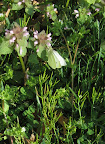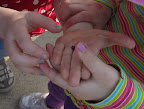On observing animals
By Peggy Ashbrook
Posted on 2012-03-25
Do you remember the book Play With Me, (Viking Press, 1955), written and illustrated by Marie Hall Ets about a child observing wildlife?  Including Play With Me, five of her book are Caldecott Honor books. I also love her book, Gilberto and the Wind. In Play With Me, a young child seeks to play with animals in the woods that border her home. The animals range from insect to amphibian to mammal, and none want to play with her. She discovers that they will come closer if she sits still. In the book, the animals come right up to the child, not a realistic expectation, but the message that wildlife can be observed, not played with, comes through.
Including Play With Me, five of her book are Caldecott Honor books. I also love her book, Gilberto and the Wind. In Play With Me, a young child seeks to play with animals in the woods that border her home. The animals range from insect to amphibian to mammal, and none want to play with her. She discovers that they will come closer if she sits still. In the book, the animals come right up to the child, not a realistic expectation, but the message that wildlife can be observed, not played with, comes through.
 I find it difficult to take groups of children for a “nature walk” to observe animals but in the small city where I teach but we did see wildlife this week: Crows flying overhead, Cabbage white butterflies, roly-polies and starlings building a nest. So often the children at the front of the group see a robin on the grass or a squirrel in a tree and rush to get a good look, loudly shushing those behind who also want to get a close look, and scaring the animal away. There isn’t time for the children to draw the animals but at least they can count them. A data collection log is a useful tool to carry with you as you walk.
I find it difficult to take groups of children for a “nature walk” to observe animals but in the small city where I teach but we did see wildlife this week: Crows flying overhead, Cabbage white butterflies, roly-polies and starlings building a nest. So often the children at the front of the group see a robin on the grass or a squirrel in a tree and rush to get a good look, loudly shushing those behind who also want to get a close look, and scaring the animal away. There isn’t time for the children to draw the animals but at least they can count them. A data collection log is a useful tool to carry with you as you walk.
If you have access to a park, arboretum, or a slightly wild border land, your students may see more animals. And if they go in small groups, such as with their family, they may be able to get closer to them. What do you think about making an information sheet describing a nearby park or natural area and listing the directions to it from the school, to give to each student to take home? The first question I got after speaking to parents at a local preschool was, “Where do you suggest we take our children to experience a natural area?” I think right outside our front doors is a good place to start but hope that all children will experience the untended places in woodlots and nature preserves often enough to become comfortable with nature as it is not controlled by humans. It is a different kind of experience in small and large ways and helps us understand our human place as part of nature. I love being outside where I’m just another animal, and I’m glad to be able to come inside when the weather is unpleasant or dangerous to me.
Does your class observe animals in nature?
Peggy
Disclaimer: The views expressed in this blog post are those of the author(s) and do not necessarily reflect the official position of the National Science Teaching Association (NSTA).


